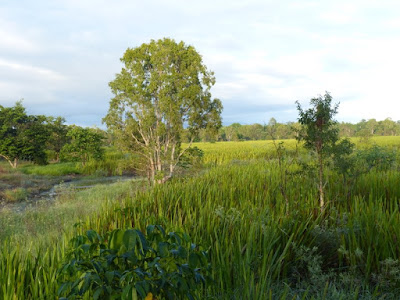Ingham is a sugar town in tropical Queensland, and a place where you'd probably not choose to spend a lot of time on your way to more salubrious spots further north. You won't find it hard however to get a decent meal and a coffee there, with over 50% of the population claiming Italian heritage. It's 17km from the sea and sitting in a sea of sugar cane, which rarely makes for environmental benefit or a particularly lovely landscape, though that of course is subjective. Nonetheless, if at all possible you should make an effort to spend a night there on your travels, for just one reason.
Anyone who reads these postings regularly will know that I have a well-developed penchant for pottering around wetlands, and this is an excellent place to potter! It is on the southern edge of town, well away from the busy town centre but still in the suburbs, west of the highway.
As you walk into the complex, initially past the football training fields, the locals will inspect you.
There is a mix of open water and reedbeds - inevitably water birds are a feature.
 |
| Intermediate Egret Ardea intermedia.Another common species and widespread beyond Australia, but too aesthetic - especially in the context of the water lilies - not to include. |
As mentioned earlier however, the site does not just comprise swampland. Trees and shrubs are scattered throughout, and many land birds use them.
 |
| More views, above and below, across Tyto Wetlands. |
 |
| Crimson Finches Neochmia phaeton are found across much of the tropical north, generally near water and in tall grassy vegetation. |
 |
| Rufous-throated Honeyeater Conopophila rufogularis.This inconspicuous little honeyeater is also generaly found near water. Unlike several of the previous species it is endemic to Australia. |
Even weeds can attract birds though (which is not a reason to plant them - the birds like native plants just as much!) One such is the attractive but highly invasive African Tulip Tree Spathodea campanulata, family Bignoniaceae, originally from sub-Saharan tropical and sub-tropical Africa from Ghana to Ethiopia and Zambia, but widely planted in north Queensland, to the detriment of the environment - they are highly invasive and can choke out gullies and waterways. There are moves to eliminate them from wild areas and it is possible that these specimens have been by now removed from Tyto.
 |
| Helmeted Friarbird Philemon buceroides in African Tulip Tree. A large and raucous tropical honeyeaer. |
 |
| The Yellow Honeyeater Lichenostomus flavus (in the same tree) is found only in tropical Queensland. |
Birds aren't the only animals flying around of course; the dragonflies didn't cooperate with my photographic efforts, but this elegant butterfly did.
 |
| Orange Bush Brown Butterfly Mycalesis terminus, family Nymphalidae. Her interest in the grass stem is not necessarily simply as a resting place - she lays her eggs almost exclusively on grasses. |
Having said that, one bird really is the star of the reserve - indeed it gave the wetland its name. Tyto is the barn owl genus, and Eastern Grass Owls T. longimembris live in the reedbeds of this wetland. There is even a viewing point dedicated to searching for them when they take flight at dusk.
 |
| Owl-viewing platform, Tyto Wetlands. |
Here are a couple of views from the platform.
 |
| Maybe you can make out the grass owl that I missed on my most recent visit. |
Either way, that's just another excellent reason to stop in next time you're driving to or from Cairns or points further north. My thanks to all those who have worked to restore, and maintain, Tyto into the world-class wetland that it is today.
BACK ON WEDNESDAY










3 comments:
I tend to agree that sugar cane farms are not scenic nor particularly environmentally great. However they do have some benefits.
1) If we didn't have the cane fields even more of the Pacific islands would be trashed for Palm Oil plantations;
2) Egrets love the frogs and reptiles which are revealed when the fields are harvested!
3) A lot of dentists would be unemployed if simple sugar were removed from our diet; and
4) Two Weavers new to science were discovered on a sugar estate in Tanzania in 1990.
Martin
Martin, that is one of the most impressively eclectic (and largely nonsensical) rationale sets that I've read for some time. Holidays clearly agree with you.
I'd be interested to know which, in your view are nonsensical - apart from #3 which is definitely mischievous!
The other three could all be justified at the expense of your readers download limits!
Martin
Post a Comment